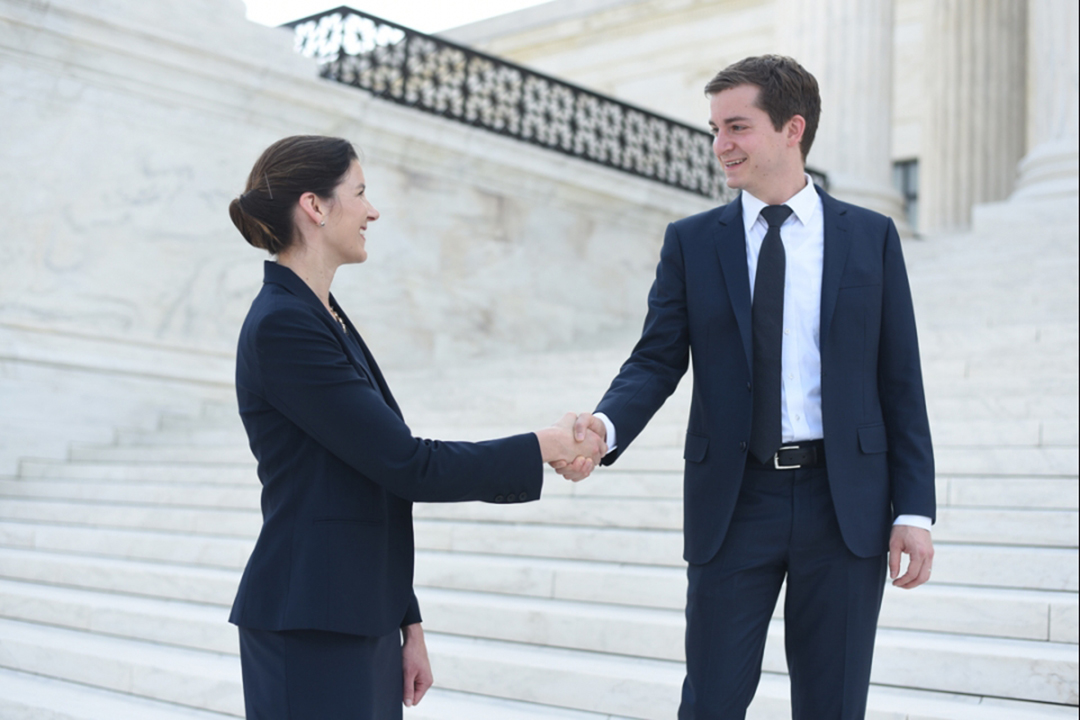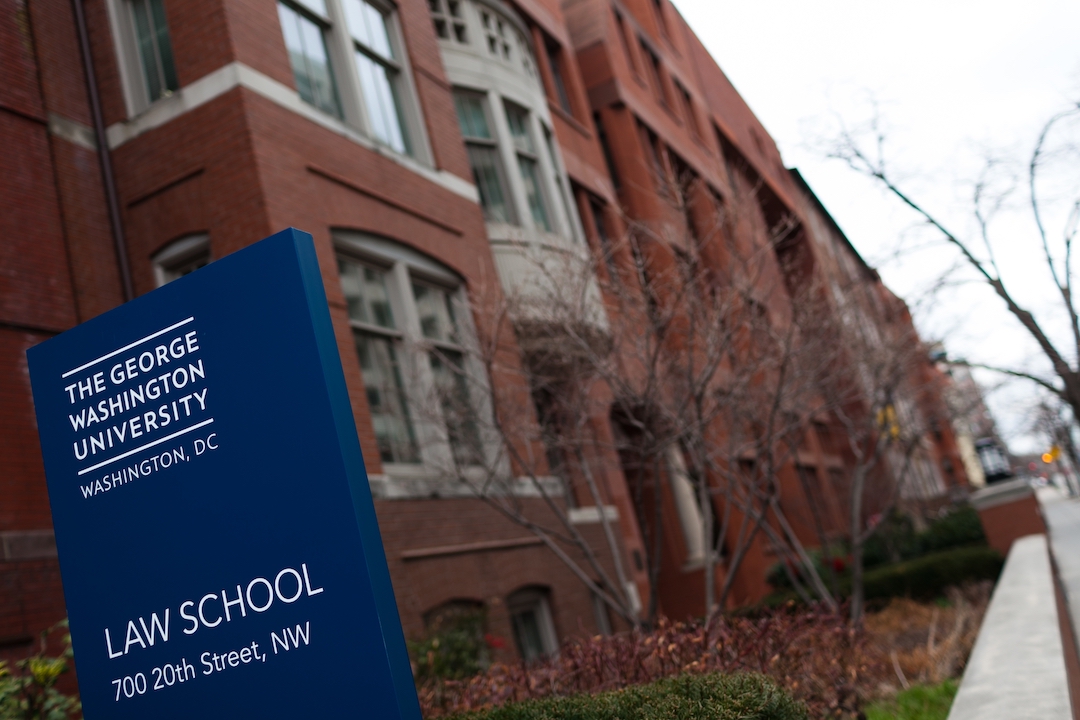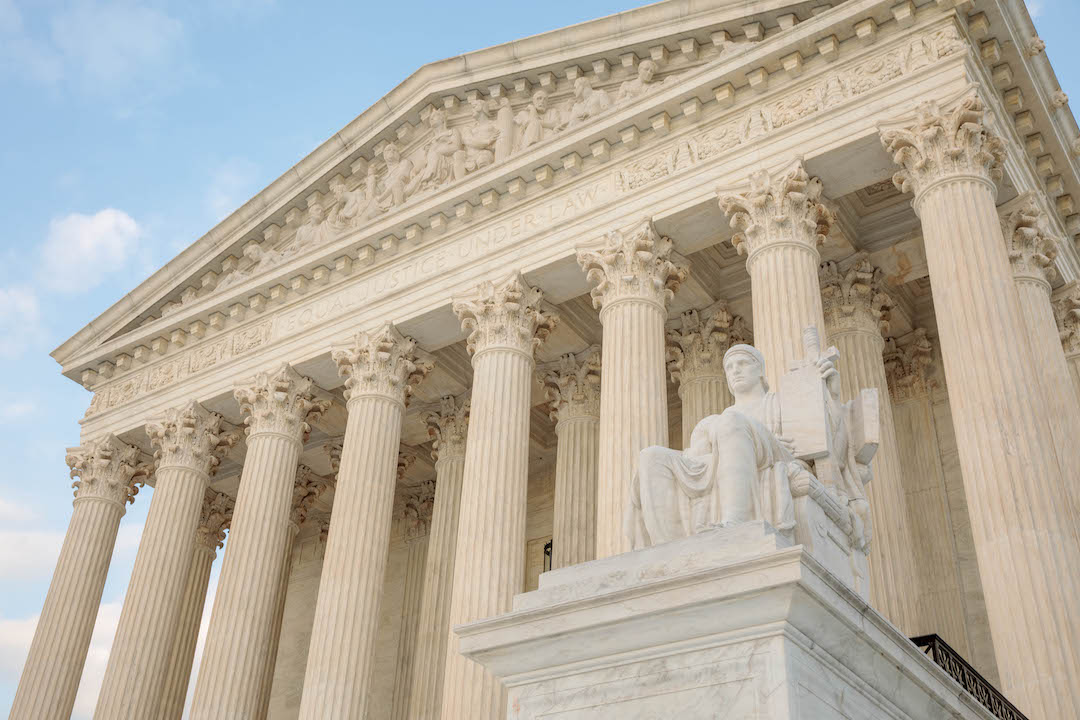By Menachem Wecker
David Fox was riding a courthouse elevator with local counsel and a client when Supreme Court Justice Stephen Breyer called offering a clerkship. Mr. Fox, J.D. ’12, who was about to walk into a Texas court hearing, had to hang up early. Shocked, he called the justice’s chambers the next day to ensure the offer was real and to confirm he was hired for the 2017-18 term.
“I benefited greatly from the support and ideas of my co-clerks for Justice Breyer and of the other clerks for other justices,” said Mr. Fox, now litigation counsel at Elias Law Group. “It really is a team effort.”
Mr. Fox; Whitney Hermandorfer, J.D. ’15, who recently completed a clerkship with Justice Amy Coney Barrett and previously clerked for Associate Justice Samuel Alito; and Zachary Tyree, J.D. ’17, who began clerking for Justice Barrett in July 2021, credit Bradford Clark, the George Washington University Law School William Cranch research professor of law, with helping them land their clerkships. In fact, said Mr. Clark, GW Law graduates like Mr. Fox are frequent fixtures in Supreme Court chambers. On average, GW tends to place a clerk on the Supreme Court every two years, and on two occasions, two of its graduates have clerked in the same year. Each of the nine justices hires four clerks a year, resulting in an annual total of about 36 clerks at the court.
A recent study ranked GW 9th nationally in placing Supreme Court clerk graduates between 2017 and 2021. Mr. Clark notes that GW Law consistently places more clerks at the Supreme Court than numerous law schools traditionally ranked higher than GW in law school rankings.
“GW Law devotes substantial resources to supporting our students' efforts to obtain clerkships at all levels,” said Mr. Clark, who himself clerked for former Associate Justice Antonin Scalia in 1989-90. “The school provides the kind of education that prepares our students to succeed in practice, including as a judicial law clerk.
“Our curriculum prioritizes broad legal knowledge across a range of essential subject matter areas and ensures that all students have substantial writing and research experience. Our location also enables students to participate in a wide variety of externships with government entities during law school, including working for judges at all levels.
“Finally, GW has a dedicated Clerkship Committee, which I co-chair with professor Laura Dickinson, designed to advise students on when, where and how to apply for clerkships."
“Walking around the building and popping into offices to chat with other clerks—and sometimes justices, even—is the norm,” Ms. Hermandorfer, now an associate at Williams & Connolly LLP, said. “To a person, each of the clerks I had the chance to work with was willing to spend time talking through issues in cases, even when we disagreed.” Those conversations continue between pickup basketball games at the court, she adds.
Mr. Clark, who has helped many GW Law alumni with Supreme Court clerkship applications, said that the nature of the work hasn’t changed much since he clerked more than 30 years ago. Clerks continue to help justices prepare for oral arguments and draft opinions and orders. One change—which the professor thinks is promising—is that the court accepts about 80 cases today compared to 120 cases years ago.
“If the court hears too many cases, it may not have adequate time to devote to each case,” he said. But annual petitions to the court have nearly doubled from 5,000 to 9,000, which creates more work for both justices and their clerks, according to Mr. Clark.
Mr. Tyree previously clerked for Judges Joan Larsen and Jeffrey Sutton of the United States Court of Appeals for the Sixth Circuit. The Lynchburg, Va., native—who answered questions about his experiences before his Supreme Court clerkship began—was a history major who considered teaching before deciding on law school.

Bradford Clark, the George Washington University Law School William Cranch research professor of law.
“I’m the first lawyer in my family, so I didn’t really have a great sense of what lawyers do. I went into it a little blind,” he said. He figured it would be fun and educational, and he only had a vague notion of what it meant to clerk on the Supreme Court. “I really had no idea how you got there,” he said.
Witnessing a judge’s thought processes, which can be brilliant, rubs off on clerks. “You pick things up through osmosis,” he said. One also gains lifelong friendships with clerks and with judges. His clerkship at the Supreme Court is the culmination of nearly two-and-a-half years of applications. “It was quite a journey, but definitely worth the wait,” he said. “I am so humbled by and thankful for the opportunity to clerk for Justice Barrett.
Ms. Hermandorfer, who has had two Supreme Court clerkships, benefited greatly from the advice of Associate Justice Brett Kavanaugh when she was clerking for him on the United States Court of Appeals for the District of Columbia Circuit.
“I remember walking the halls of the court prior to my interview with Justice Alito. The magnitude of just being in the building was almost overwhelming,” she said. “I told myself that, worst-case scenario, I would have the opportunity to meet a justice and talk with him about the law.” She was able to continue that conversation over a much longer time period—something she had dreamt of doing but had never imagined would become reality.
“Working for Justices Alito and Barrett was the honor of a lifetime. Although they each have distinct styles of communicating and thinking through cases, both approach the preparation process and their relationships with their clerks with great respect,” she said. “It’s both humbling and inspiring to see just how great a lawyer each is—whether it’s listening to Justice Alito deliver oral argument questions or watching Justice Barrett craft the perfect introduction to an opinion.” Both also care deeply about their clerks as people, she said.
Before receiving that phone call in the Dallas elevator, Mr. Fox clerked for Judge David Barron on the United States Court of Appeals for the First Circuit. The judge recommended he consider applying to the Supreme Court, which proved a lot of work. He penned a new writing sample for his application and renewed and deepened connections with law school professors. He was thrilled to clerk for Justice Breyer, whose pragmatism and non-ideological legal approach he appreciates.
“He is a modern-day renaissance man to an unparalleled extent,” Mr. Fox said. The justice speaks fluent French and was learning Spanish when he clerked for him.
“When I interviewed with him, we talked at least as much about the causes of World War I as we did about the law,” he said. “Justice Breyer brings all of that depth of knowledge to his job, and it makes him just a delightful person to work for.”
Clerking for the Supreme Court is an “unparalleled opportunity to confront some of the most difficult legal questions in the country, in the company of some of the best lawyers in the country,” Mr. Fox said.
For current students who would like to clerk for the Supreme Court, professor Clark recommends keeping grades up and demonstrating legal writing and research excellence.
“The competition for Supreme Court clerkships is fierce, and only the very best students receive interviews for these positions,” he said. “Any aspiring lawyer with a federal court of appeals clerkship and a strong work ethic should apply to the court.”




